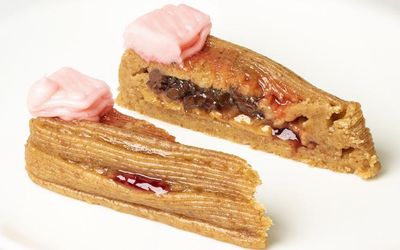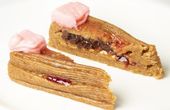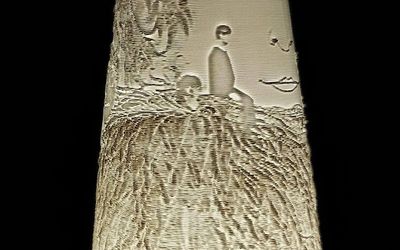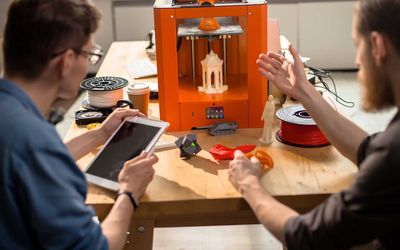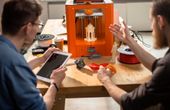Stratasys F370
The largest and most versatile 3D printer of the F123 Series printer offering industrial-grade capability with simple operation.
Technical Specifications
| Dimensions | 1,626 x 864 x 711 mm (64 x 34 x 28 in) |
| Weight | 227 kg (500lbs) with consumables |
| Technology | FDM® technology |
| Noise Specifications | During build: 48 dB |
| When idle: 35 dB | |
| Thermal | Extruder ≤300° C |
| Chamber ≤110° C, active convection | |
| Build Size | 355 x 254 x 355 mm (14 x 10 x 14 in.) |
| Layer Thickness: ABS, ASA, PC-ABS | 0.330mm (0.013 in), 0.254mm (0.010 in), 0.178mm (0.007 in), 0.127mm (0.005 in) |
| Layer Thickness: Diran 410MF07, ABS-CF103, ABS-CF103 | 0.330mm (0.013 in), 0.254mm (0.010 in) ,0.178mm (0.007 in) |
| Layer Thickness: PLA, FDM TPU 92A, ABS-ESD7 | 0.254mm (0.010 in) |
| Model Materials | PLA2, ABS-ESD7™, ABS-M30, ASA, Diran™ 410MF072, FDM TPU 92A, PC-ABS, ABS-CF10, QSR Support material |
| Cartilage Capacity | 4 material spool bays |
| 2 for model, 2 for support located in a drawer on the front of the unit | |
| Software | GrabCAD Print & Insight software license |
| Network Connectivity | Wired: TCP/IP protocols at 100 Mbps minimum 100 base T, Ethernet protocol, RJ45 connector |
| Wireless-ready: IEEE 802.11n, g, or b; Authentication: WPA2-PSK, 802.1x EAP; Encryption: CCMP, TKIP | |
| System Requirements | Windows 7, 8, 8.1 and 10 (64bit only) with a minimum of 4GB RAM (8GB or more recommended) |
| Operating Environment | Operating: Temperature: 15 – 30 ºC (59 – 86 ºF), Humidity: 30 – 70% RH |
| Storage: Temperature: 0 – 35 ºC (32 – 95 ºF), Humidity: 20 – 90% RH | |
| Power Requirements | 100–132V/15A or 200–240V/7A. 50/60 Hz |
Overview
The fused deposition method (FDM) technology has innovated additive manufacturing by creating aids, tools, and production parts for a broad variety of industries. As suppliers and end-users invest substantially in FDM, it leads to the production and utilization of solutions for diverse applications and wide-scale usage. For such an additive manufacturing technology to blend in the manufacturing workflow, solutions combining software, hardware, and material deliver a solid and foreseeable performance. The repeatability of a solution likewise requires equivalent importance to deliver intra- and inter-machine results consistently over time.
F123 Series printers boast industrial-grade capability mixed with simple operation. Using F123 printers requires no special expertise as it offers carbon fiber 3D printing with easy and fast material swaps on top of auto-calibration.
Among this series, Stratasys F370 offers the versatility with its access to a wide material range, such as carbon fiber, elastomer, and ABS. It can achieve complex geometries and component interlocking using a unique soluble support material. Among its F123 siblings, Stratasys F370 has the largest print bed aside from having the widest material range and bundled support for software GrabCAD print and Insight. It likewise delivers accurate and dependable results consistently with a 95% Job Yield and 99% Part Yield.
Description
The Stratasys F370 prints accurate and professional 3D results by combining the FDM® technology with GrabCADPrint, a design-to-print software. It spans 1,626 x 864 x 711 mm with a build size of 355 x 254 x 355 mm. It has a 48 dB noise specification during the build and 35 dB when idle. The cartilage on the front can hold 4 materials spool bays, two each for the model and support. It requires 100–132V/15A or 200–240V/7A on a 50-60HZ supply for power. F370 complies with the US Department of Defense STIG, having the ProtectAM technology that provides print data security.
Printing
In the fast-draft mode, the device quickly and economically prints initial design concepts, requiring an average consumption of half the material. The hands-free soluble support allows the construction of complex parts with top-notch accuracy and detail. The extruder can reach a temperature of ≤300° C and the chamber ≤110° C during active convection. ABS, ASA, and PC-ABS have a layer thickness set of 0.330mm, 0.254mm, 0.178mm, and 0.127mm. Diran 410MF07, ABS-CF103, and ABS-CF103 have a layer thickness set of 0.330mm, 0.254mm, and 0.178mm, while PLA, FDM TPU 92A, and ABS-ESD7 only have a 0.254mm layer thickness.
Software
With the Insight software, users can visualize designs prior to printing. This new way allows them to perfect designs and fine-tune every detail down to the layer. It even allows the allocation of extra density in the weak points of the design and alteration of properties, such as heat tolerance, weight, and strength.
On the other hand, simplifying the conventional 3D print preparation is the GrabCAD Print, which gives intelligence to printer usage. It details the design model, slice, and tray previews, allowing needed adjustments before the actual printing. It likewise gives FDM updates that improve speed and model customization. With geometry-targeted tools, it can minimize weight and material without jeopardizing strength. Meanwhile, the new feature ‘adaptive slice’ automatically varies the slice height, which allows for a decreased printing time that does not compromise strength and quality. More so, the device prints high-resolution parts 24% faster than before. GrabCAD print, just like Insight, grants 360-degree control over the design all throughout the process.
Network Connectivity
The printer supports wired connection through the RJ45 connector, Ethernet Protocol, or TCP/IP protocols at a minimum of 100Mbps. For wireless connectivity, the device connects to IEEE 802.11n, g, or b, authenticated with WPA2-PSK, 802.1x EAP, and encrypted via CCMP or TKIP. The cloud-connected GrabCAD is accessible for monitoring directly from every browser or the user’s mobile device. It prints to every supported printer in a company despite different geographic locations. The straightforward interface of loading and clicking print makes professional 3D printing an easy task.
Materials
The printer’s material versatility opens for multiple applications, creating strong yet light manufacturing tools, fixtures, and jigs. The stiff thermoplastic Polylactic Acid (PLA) suits best for cheap and fast concept verification. It works with the fast-draft mode in 11 color options. PLA requires lesser heat and power as it has a low melting point, but can still offer a nice tensile strength with its high stiffness ratio. The strong ABS-M30 is a thermoplastic best for a lot of 3D printing applications, may it be concept modeling and moderate-requiring parts, like prototypes, fixtures, and production parts.
For electronic applications, the static dissipative qualities of ABS-ESD7 make it a perfect match for parts with circuit boards and those in transportation and industrial applications. With a 92 Shore A value, the thermoplastic polyurethane FDM TPU 92A eliminates time-consuming molding methods for flexible elastomer parts, like hoses, air ducts, tubes, and vibration dampeners. The durable nylon-based Diran 410MF07 demonstrates phenomenal toughness and hydrocarbon-based chemical-resistance. This thermoplastic gives the best results in non-marring floor tooling that requires a smooth and low-friction surface.
Similar to ABS, the UV-resistant ASA (Acrylonitrile Styrene Acrylate) can produce a smoother print surface requiring strength and outdoor use. ABS-CF10 fuses carbon fiber filament with ABS’s worthwhile mechanical properties. Lastly, the high-impact PC-ABS is the engineering thermoplastic best for functional tooling, prototyping, and manufacturing at low volume.



